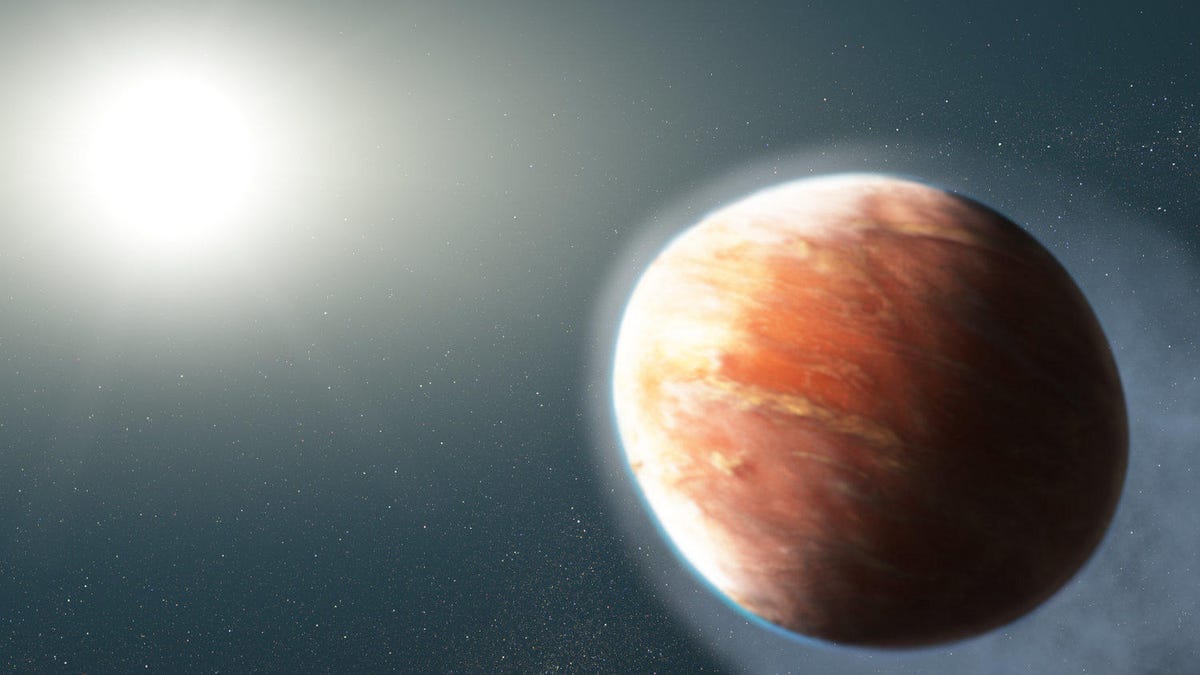NASA's Hubble Telescope Spies an Ultrahot Jupiter Where It Rains Liquid Gems
WASP-121b becomes a muse for astronomers, who find uncut gems could precipitate from its dark side.

This artist's impression shows how WASP-121b is getting bent out of shape.
The exoplanet WASP-121b, which resides about 900 light-years from Earth, is an egg-shaped scorcher. Temperatures on the planet's day side can reach up to 4,600 degrees Fahrenheit. It's so hot that heavy metal elements, like iron and magnesium, exist as gases and are constantly streaming out of the atmosphere and into space.
But the planet's night side has, until now, remained in the dark (sorry).
In a new study, published in the journal Nature Astronomy on Feb. 21, astronomers shared their first look at the planet's dark side using NASA's Hubble Telescope.
Telescopes at the South African Astronomical Observatory discovered WASP-121b in 2015. The planet, which is a little bigger and heavier than Jupiter, is on the verge of being ripped apart by the gravitational forces of its home star, known as WASP 121. It makes a full orbit of that star once every 1.3 days and is tidally locked -- one side is perpetually bathed in starlight, the other is forever staring out into space.
"This is one of the most extreme systems we have," says Ben Montet, an astrophysicist at the University of New South Wales who was not affiliated with the study. He notes its extremely hot day side is hotter than some stars.
Hubble has been instrumental in learning more about WASP-121b's atmosphere, first revealing in 2017 that it contains water vapor and suggesting the planet contains a stratosphere -- a first. The new study turned to Hubble once again and reveals, in detail, the planet's atmosphere and how the temperature change from day to night affects the elements that fly around the hot Jupiter's upper layers.
Hubble trained its cosmic eye on WASP-121b for two full orbits of its home star, once in 2018 and a second time a year later. Hubble's "eye" collects light data, which scientists can break down into wavelengths that correspond to particular elements and molecules. The team looked for water vapor on the night side of WASP-121b and used it to determine how "cold" the dark side gets.
The answer: The night side gets down to about 2,200 degrees Fahrenheit. Not very cold in Earth terms, but super cold compared to WASP-121b's day side. They were also able to calculate wind speeds on the planet exceeding 11,000 miles per hour.
With this information, the team then modeled what other kinds of chemicals and molecules might exist in the exoplanetary atmosphere. They found the night side likely contains exotic clouds made of iron and titanium, as well as corundum, the same mineral that is found in ruby and sapphire gemstones on Earth. The clouds get whipped from the night side to the day side and find themselves in an extremely hostile environment where they condense and fall, like rain.
"All of these exotic compounds are raining out of the planet's atmosphere," said Montet. Essentially, if you could survive in WASP-121b, you might see the liquid version of rubies and sapphires fall out of the sky.
NASA's recently launched James Webb Space Telescope is expected to observe WASP-121b later this year. The telescope will assess the planet in infrared and analyze its atmospheric chemistry, allowing scientists to get a better understanding of how hot Jupiters might form and exactly what its atmosphere is composed of.

